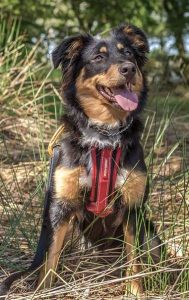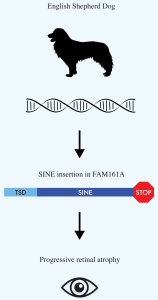 Back in March, CAGT launched a DNA test for progressive retinal atrophy (PRA) in the English Shepherd Dog breed (PRA6). Since then we have been working on a manuscript detailing our research and we are very pleased to announce that it was published last Sunday in Genes.
Back in March, CAGT launched a DNA test for progressive retinal atrophy (PRA) in the English Shepherd Dog breed (PRA6). Since then we have been working on a manuscript detailing our research and we are very pleased to announce that it was published last Sunday in Genes.
Stanbury K, Schofield EC, McLaughlin B, Forman OP, Mellersh CS. Exonic Short Interspersed Nuclear Element Insertion in FAM161A Is Associated with Autosomal Recessive Progressive Retinal Atrophy in the English Shepherd. Genes. 2024; 15(7):952. doi: 10.3390/genes15070952
 So, what is the genetic variant causing this blinding disease in the English Shepherd? The variant identified in our research is classed as a ‘structural variant’. More specifically, it is an insertion of a repetitive section of DNA known as a short interspersed nuclear element (SINE), and was identified in a gene called FAM161A. SINEs are not always disease causing, they are actually extremely common in the dog genome. However, the SINE in the English Shepherd PRA cases is inserted into an exon, which is the part of DNA that is translated by RNA to make a protein. There are two forms of the FAM161A protein, a short one that contains 6 exons and a long form that contains 7 exons. The short form lacks exon 4 which is alternatively spliced out and both are expressed in the retina.
So, what is the genetic variant causing this blinding disease in the English Shepherd? The variant identified in our research is classed as a ‘structural variant’. More specifically, it is an insertion of a repetitive section of DNA known as a short interspersed nuclear element (SINE), and was identified in a gene called FAM161A. SINEs are not always disease causing, they are actually extremely common in the dog genome. However, the SINE in the English Shepherd PRA cases is inserted into an exon, which is the part of DNA that is translated by RNA to make a protein. There are two forms of the FAM161A protein, a short one that contains 6 exons and a long form that contains 7 exons. The short form lacks exon 4 which is alternatively spliced out and both are expressed in the retina.
The SINE insertion identified in the English Shepherd PRA cases is located in the fourth exon of FAM161A, so this would impact on the longer form. The insertion remains in frame, meaning that it its sequence is most likely translated and incorporated into the protein. The inclusion of the SINE would extend exon 4 by 39 abhorrent amino acids, compared to the normal sequence, and then translation would come to a stop in exon 4 as the next amino acid sequence codes for a stop codon. This would result in a truncated protein containing only 4 exons as opposed to the normal 7 and would most likely have a deleterious effect on protein functionality.
The FAM161A protein has been shown to play a crucial role in maintaining a specialised structure within photoreceptor cells known as the connecting cilium. This structure acts as a kind of bridge that facilitates the transport of numerous proteins that are needed for cell structure and maintenance, from the inner to the outer segments of the photoreceptor. Photoreceptors are vital for vision, they perform phototransduction which is the process that captures and converts light signals into electrical signals passed to the brain. So if FAM161A is absent or defective, the connecting cilium slowly collapses and ultimately results in the death of the photoreceptor cell.
As with many forms of PRA, the disease in the English Shepherd is recessively inherited. So a dog would only be affected if they had two copies of the SINE insertion. Dogs that carry a single copy of the FAM161A mutation won’t develop PRA, but they will pass the mutation onto about half of any offspring they produce, so judicious use of DNA screening is important to identify carriers and make sure that they are not mated to other carriers. For more advice about breeding with carriers please see our article published in May 2024.

